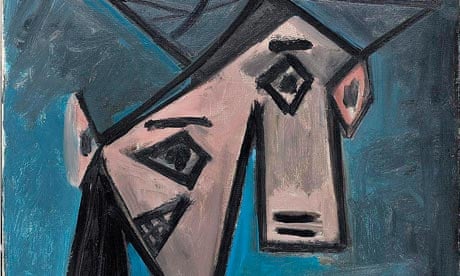A Picasso gifted to the Greek people by the artist in honour of their resistance to Nazi rule has been found in a gorge after a builder admitted to stealing the masterpiece and two other artworks in an audacious theft from the National Gallery in Athens nearly a decade ago.
For nine years, Head of a Woman had lain hidden in the home of the self-described art lover alongside Stammer Windmill, a work by the Dutch painter Piet Mondrian, also stolen during the overnight raid on 9 January 2012.
Fearing authorities were about to trace him, the thief transferred the priceless pieces to a warehouse before concealing both in protective wrapping and hiding them in a gorge south-east of the capital in the spring.
Their recovery was greeted with elation in Athens. The National Gallery, Greece’s biggest public collection, only recently reopened after being closed for years for renovation.
The culture minister, Lina Mendoni, described the presentation of the retrieved works as “a special day, [a day of] great joy and emotion”. Pablo Picasso, she said, had personally donated the Cubist painting to the nation in 1949 five years after Hitler’s troops withdrew from the country, inscribing the words “for the Greek people, a tribute. Picasso” on the back of the canvas.

“This painting is of particular importance and sentimental value … as it was personally dedicated by the great painter to the Greek people for their fight against fascist and Nazi forces,” she told a news conference. “It would have been impossible to sell.”
Praising Greek police for solving the crime, the country’s citizens’ protection minister, Michalis Chrisohoidis, said it “took a Greek to deprive” the nation of the masterpiece and “Greeks to bring it back”.
The incident had been called the theft of the century, shocking the nation and leaving police astonished by its audacity. The burglary took no more than seven minutes. In that time the paintings were stripped of their frames before being spirited out of the gallery through a smashed balcony door after the alarm system was manipulated to send the sole guard, then on duty, in another direction.
A sketch by the 16th-century Italian artist Guglielmo Caccia, better known as Moncalvo, was also snatched but the arrested builder allegedly told police that after it was damaged in the robbery he decided to discard it in a toilet.
A fourth work, another Mondrian, was similarly targeted but dropped as he fled the scene.
The 2012 break-in occurred at the height of the country’s economic crisis. The gallery’s poor security system and lack of guards were attributed to the punitive austerity measures Athens was forced to implement in return for international loans to keep bankruptcy at bay.
An inquiry subsequently found that the National Gallery’s alarm system had not been upgraded for more than a decade. Several areas of the museum, which hosts more than 20,000 art pieces, were out of range of security cameras.
The theft appeared so well organised that for years authorities had worked on the assumption an experienced gang was behind the crime. The revelation on Tuesday that it had instead been the work of “an art lover” who, according to Skai TV, simply wanted “to possess the pieces”, took many by surprise.
The builder, described by Greek media as a 49-year-old divorcee, allegedly denied having an accomplice, reportedly telling police he had planned the burglary for six months and had even travelled to and from the gallery on the night of the raid by public transport.
During that period he had visited the gallery on an almost daily basis, he claimed, so he could scout it out and watch the movement of the guards “down to when they took cigarette breaks”, according to extracts of his testimony published by news outlets.
“I have a passion for art,” he is reported to have told investigators when brought in for questioning, rejecting suggestions he had wanted to sell the artworks.
Skai TV reported the builder had also told police he regularly travelled to Britain for the sole purpose of going to exhibitions and “seeing art”.
Sakis Kehayioglou, a veteran lawyer acting for the accused, said he had shown “real remorse” for his actions.
“It is an indisputable fact that in the discovery and recovery [of the works] my client played a decisive role,” he said, adding he had cooperated fully with the authorities and ultimately helped them unearth the paintings.















